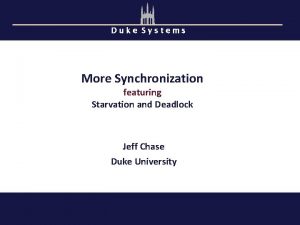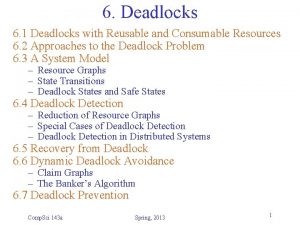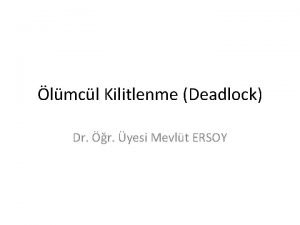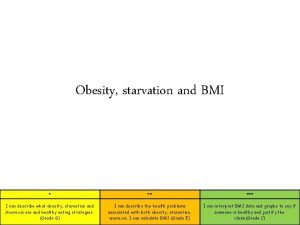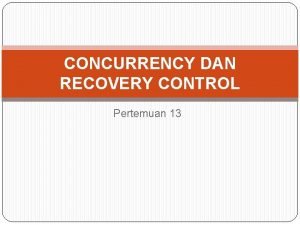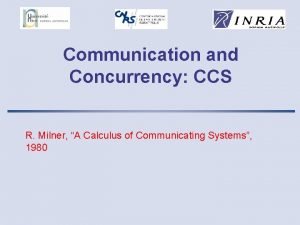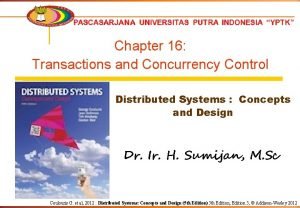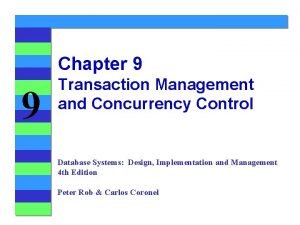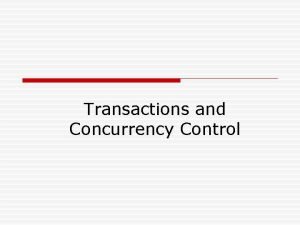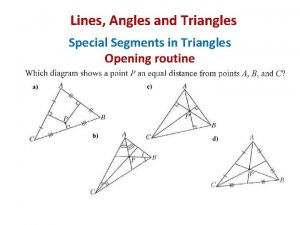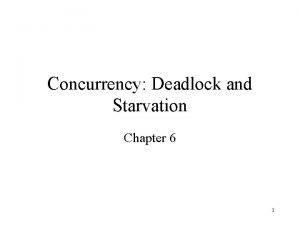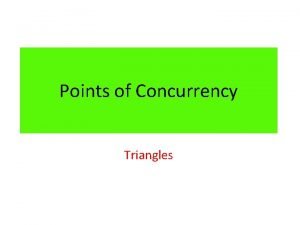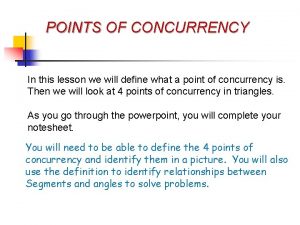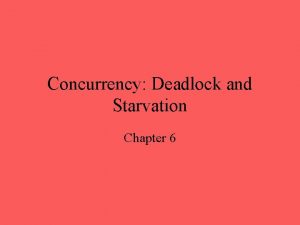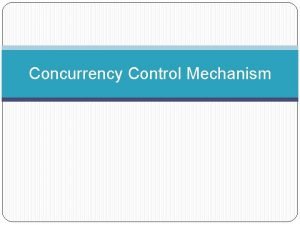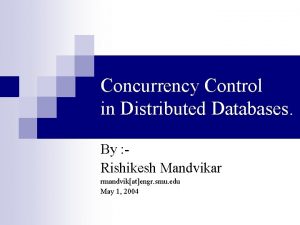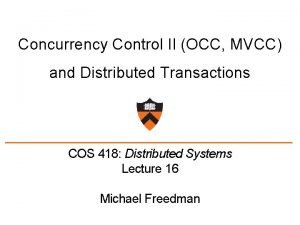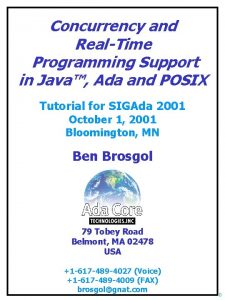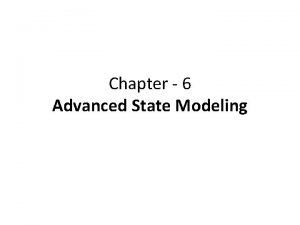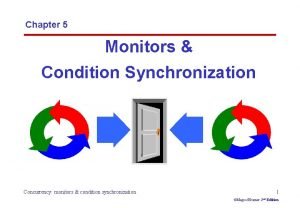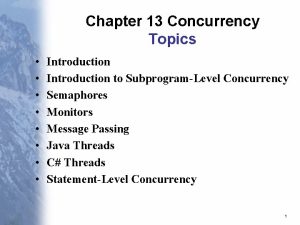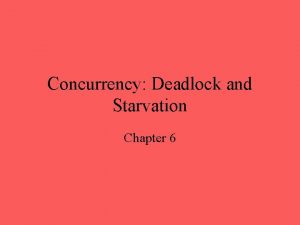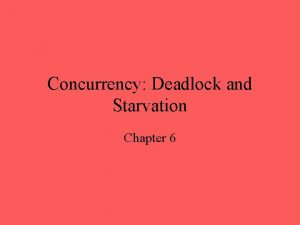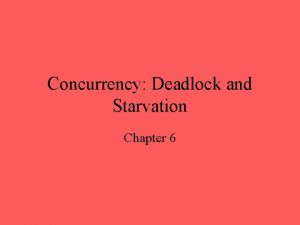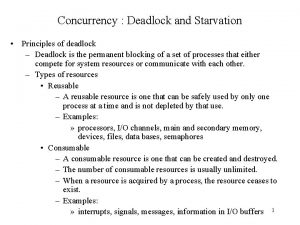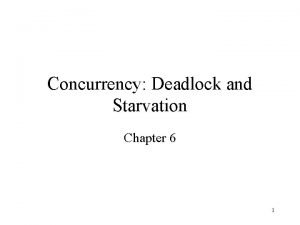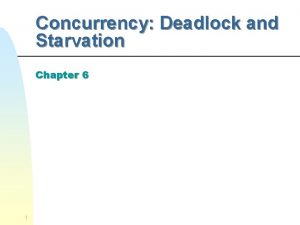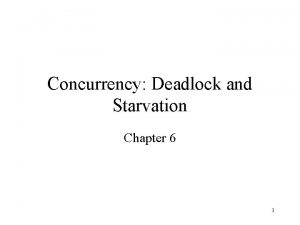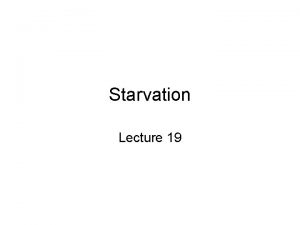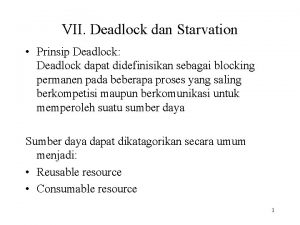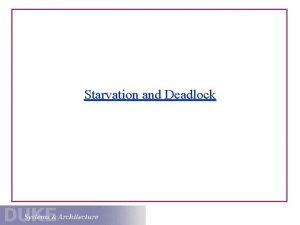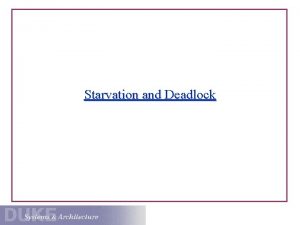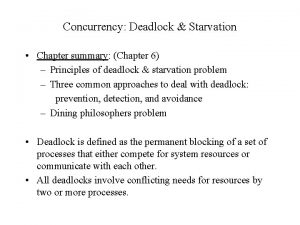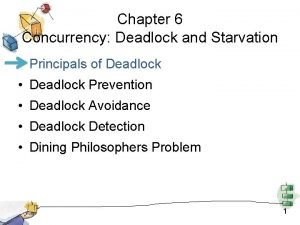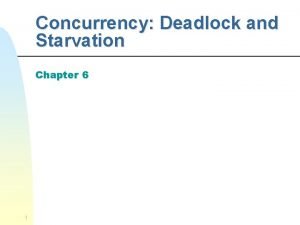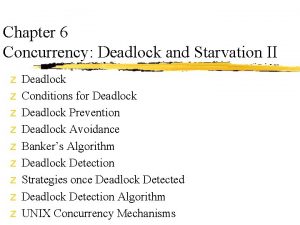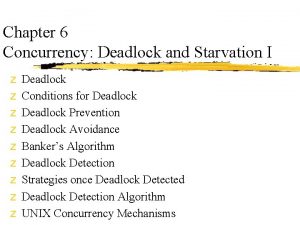Chapter 6 Concurrency Deadlock and Starvation Deadlock Permanent



































- Slides: 35

Chapter 6 Concurrency: Deadlock and Starvation

Deadlock • Permanent blocking of a set of processes that either compete for system resources or communicate with each other • No efficient solution • Involve conflicting needs for resources by two or more processes

Deadlock

Deadlock

Reusable Resources • Used by only one process at a time and not depleted by that use • Processes obtain resources that they later release for reuse by other processes – Processors, I/O channels, main and secondary memory, devices, and data structures such as files, databases, and semaphores • Deadlock occurs if each process holds one resource and requests the other

Reusable Resources

Consumable Resources • Created (produced) and destroyed (consumed) • Interrupts, signals, messages, and information in I/O buffers • Deadlock may occur if a Receive message is blocking

Example of Deadlock • Deadlock occurs if receives blocking

Example of Deadlock Semaphore a=1, b=1; T 1: void f () { wait(a); wait(b); … signal (b); signal(a); } T 2: void f () { wait(b); wait(a); … signal (a); signal(b); }

Resource Allocation Graphs • Directed graph that depicts a state of the system of resources and processes

Resource Allocation Graphs

Conditions for Deadlock • Mutual exclusion – Only one process may use a resource at a time • Hold-and-wait – A process may hold allocated resources while awaiting assignment of others • No preemption – No resource can be forcibly removed form a process holding it • Circular wait – A closed chain of processes exists, such that each process holds at least one resource needed by the next process in the chain.

Resource Allocation Graphs

Possibility of Deadlock • Mutual Exclusion • No preemption • Hold and wait

Existence of Deadlock • • Mutual Exclusion No preemption Hold and wait Circular wait

Deadlock Prevention • Mutual Exclusion • Hold and Wait – Require a process request all of its required resources at one time • No Preemption – Process must release resource and request again – OS may preempt a process to require it releases its resources • Circular Wait – Define a linear ordering of resource types

Deadlock Avoidance • A decision is made dynamically whether the current resource allocation request will, if granted, potentially lead to a deadlock • Requires knowledge of future process requests

Two Approaches to Deadlock Avoidance • Do not start a process if its demands might lead to deadlock • Do not grant an incremental resource request to a process if this allocation might lead to deadlock

Resource Allocation Denial • Referred to as the banker’s algorithm • State of the system is the current allocation of resources to process • Safe state is where there is at least one sequence that does not result in deadlock • Unsafe state is a state that is not safe

Determination of a Safe State

Determination of a Safe State

Determination of a Safe State

Determination of a Safe State

Determination of an Unsafe State

Deadlock Avoidance Logic

Deadlock Avoidance Logic

Deadlock Avoidance • Maximum resource requirement must be stated in advance. • Processes under consideration must be independent; no synchronization requirements. • There must be a fixed number of resources to allocate. • No process may exit while holding resources.

Deadlock Detection

Strategies Once Deadlock Detected • Abort all deadlocked processes • Back up each deadlocked process to some previously defined checkpoint, and restart all process – Original deadlock may occur • Successively abort deadlocked processes until deadlock no longer exists • Successively preempt resources until deadlock no longer exists

Dining Philosophers Problem

Dining Philosophers (Dead. Lock Possible)

Dining Philosophers (No Dead. Lock)

Dining Philosophers Problem (with Monitors)

Dining Philosophers Problem

UNIX Concurrency Mechanisms • • • Pipes Messages Shared memory Semaphores Signals
 Deadlock and starvation
Deadlock and starvation Deadlock and starvation
Deadlock and starvation![Deadlocked in time [ch. 6 part 2] Deadlocked in time [ch. 6 part 2]](data:image/svg+xml,%3Csvg%20xmlns=%22http://www.w3.org/2000/svg%22%20viewBox=%220%200%20200%20200%22%3E%3C/svg%3E) Deadlocked in time [ch. 6 part 2]
Deadlocked in time [ch. 6 part 2] Starvation vs deadlock
Starvation vs deadlock Deadlock prevention vs avoidance
Deadlock prevention vs avoidance Starvation vs deadlock
Starvation vs deadlock Starvation deadlock
Starvation deadlock Starvation method of extinguishing fire
Starvation method of extinguishing fire Flow starvation waveform
Flow starvation waveform Chapter 5 nutrition guidelines tools for healthful eating
Chapter 5 nutrition guidelines tools for healthful eating Beyonce bmi
Beyonce bmi Starvation diabetes mellitus
Starvation diabetes mellitus Tureen analogy
Tureen analogy Pessimistic concurrency control
Pessimistic concurrency control Apa yang dimaksud dengan recovery
Apa yang dimaksud dengan recovery Ccs milner
Ccs milner Safety and liveness in concurrency
Safety and liveness in concurrency Transactions and concurrency control in distributed systems
Transactions and concurrency control in distributed systems Transaction management and concurrency control in dbms
Transaction management and concurrency control in dbms Example of concurrency control in dbms
Example of concurrency control in dbms Special segments of triangles
Special segments of triangles Transaction management and concurrency control
Transaction management and concurrency control Deadlock chapter 37
Deadlock chapter 37 Triangle points of concurrency
Triangle points of concurrency Points of concurrency
Points of concurrency Concurrency in web applications
Concurrency in web applications Perpendicular bisector concurrency conjecture
Perpendicular bisector concurrency conjecture Ue4 tmap thread safe
Ue4 tmap thread safe Unix concurrency mechanisms
Unix concurrency mechanisms Concurrency control mechanisms
Concurrency control mechanisms Concurrency control in distributed databases
Concurrency control in distributed databases Timemasters locks
Timemasters locks Ada concurrency
Ada concurrency Aggregation concurrency in state diagram
Aggregation concurrency in state diagram Concurrency
Concurrency Explain subprogram level concurrency with an example
Explain subprogram level concurrency with an example
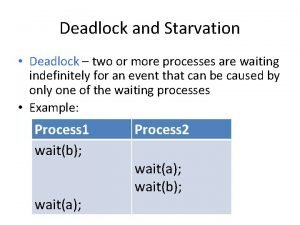

![Deadlocked in time [ch. 6 part 2] Deadlocked in time [ch. 6 part 2]](https://slidetodoc.com/wp-content/uploads/2021/03/4924895_2b47774288878079cc9245da8c4d6b36-300x225.jpg)
